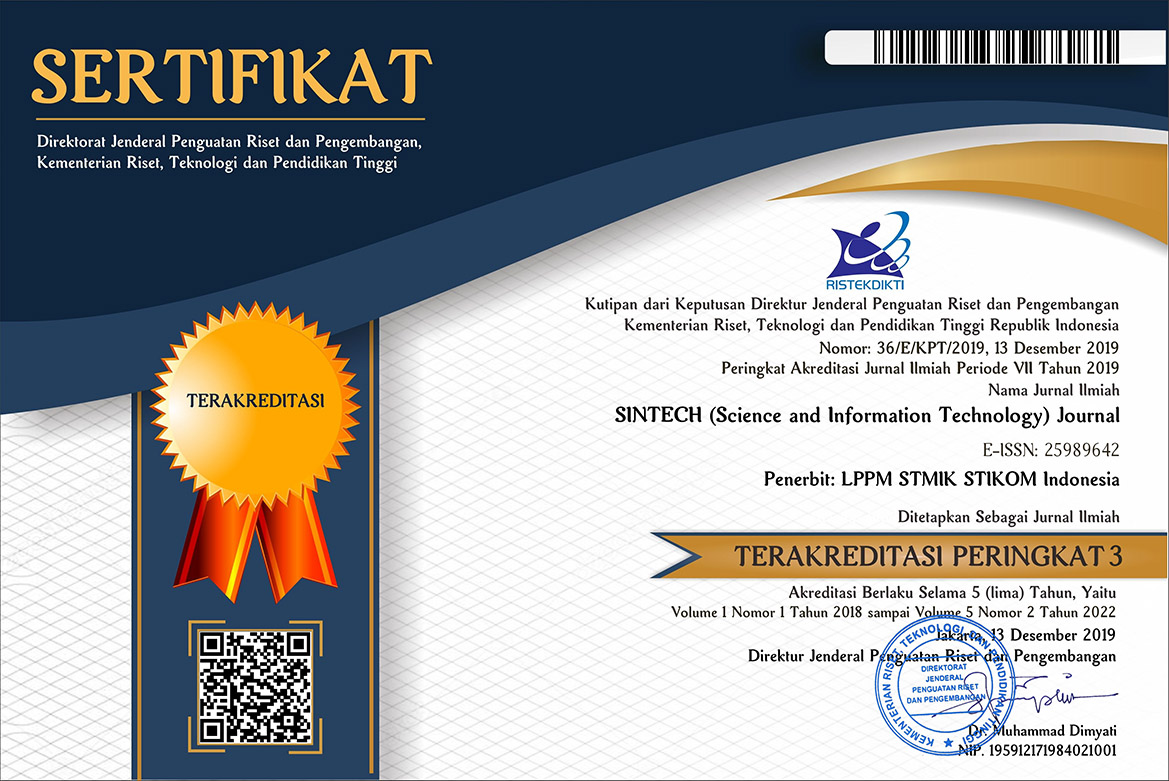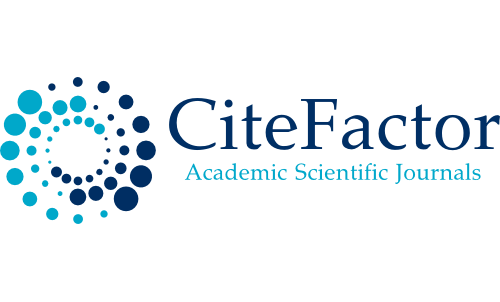Detecting Emotions of Indonesian Songs Based on Plutchik’s Theory using Data Mining
DOI:
https://doi.org/10.31598/sintechjournal.v7i1.1509Keywords:
Plutchik's Theory, Data Preprocessing, Data Mining, Cosine SimilarityAbstract
Listening to songs is a daily activity that everyone engages in. Most people choose songs based on their mood, so a system is needed to detect emotions from song lyrics. Previous research only focused on five basic emotions: happy, sad, love, anger, and fear. In this study, we propose a new method to detect emotions from song lyrics using Plutchik's emotion theory. The data used for this research consisted of 250 song lyrics from Indonesian songs. This research categorizes human emotions into eight: joy, trust, surprise, sadness, disgust, anger, and anticipation. Next, the threshold value is calculated. This value is used to determine the dominant emotion. If the frequency value of an emotion is higher than the threshold value, the system considers it as the dominant emotion. The dominant emotions are then classified into positive and negative emotions using cosine similarity calculations. The sampling technique involves using 30% of the test data, resulting in an accuracy of 0.81.
Downloads
References
Spotify, “The Top Songs, Artists, Podcasts, and Listening Trends of 2023 Revealed,” 2023. https://newsroom.spotify.com/2023-11-29/top-songs-artists-podcasts-albums-trends-2023/#:~:text=As always%2C our 2023 Spotify,the world listened this year
F. S. S. Sinaga and E. Winangsit, “Terapi Musik untuk Meningkatkan Kesehatan Mental: Tinjauan Literatur dalam Perspektif Psikodinamika,” Assert. Islam. Couns. J., vol. 02, no. 1, pp. 1–12, 2023.
A. M. W. Aru, “E-Modul Seni Budaya Kelas XI,” Angew. Chemie Int. Ed. 6(11), 951–952., pp. 5–24, 2018.
A. Yanti, P. A. Lubis, N. A. Natasha, E. Sitorus, and F. L. Barus, “Analisis Makna Leksikal Pada Lirik Lagu Kamu Dan Kenangan Karya Maudy Ayunda,” Asas J. Sastra, vol. 2, no. 3, p. 86, 2021, doi: 10.24114/ajs.v10i2.26269.
F. R. Zain, “Memahami Hakikat Kehidupan Melalui Lirik Lagu Karya Banda Neira (Tinjauan Semantik: Metafora),” Kaji. Linguist. dan Sastra, vol. 6, no. 2, pp. 164–175, 2021, doi: 10.23917/kls.v6i2.9589.
I. P. D. Fortunawan, N. Agus, and S. Er, “Klasifikasi Emosi Lirik Lagu dengan Long Short-Term Memory dan Word2Vec,” vol. 1, pp. 1203–1208, 2023.
H. Sastypratiwi, H. Muhardi, and M. Noveanto, “Klasifikasi Emosi Pada Lirik Lagu Menggunakan Algoritma Multiclass SVM dengan Tuning Hyperparameter PSO,” J. Media Inform. Budidarma, vol. 6, no. 4, p. 2279, 2022, doi: 10.30865/mib.v6i4.4609.
W. Hermanto, B. Irawan, C. Setianingsih, and U. Telkom, “Klasifikasi Emosi Pada Lirik Lagu Menggunakan Algoritma Support Vector Machine Dan Optimasi Particle Swarm Optimization Classification of Emotions in Song Lyrics Using Support Vector Machine Algorithm and Particle Swarm,” vol. 8, no. 5, pp. 6307–6327, 2021.
G. S. Ramadhan, B. Irawan, C. Setianingsih, and U. Telkom, “Klasifikasi emosi pada lirik lagu menngunakan algoritma naïve bayes dan particle swarm optimization classification of emotions on song lyrics using naïve bayes algorithm and particle swarm optimization,” e-Proceeding Eng., vol. 8, no. 5, pp. 6293–6306, 2021.
R. Damara, R. Kezia, G. Bagus, and H. Putri, “IJM : Indonesian Journal of Multidisciplinary Klasifikasi Emosi yang Terdapat Dalam Lirik Lagu ‘ Jiwa yang Bersedih ’ Karya Ghea Indrawari,” vol. 1, pp. 2139–2147, 2023.
W. Alan, “Klasifikasi Emosi pada teks menggunakan Deep Learning,” Tugas Akhir di Univ. Islam Indones., vol. 6, no. 1, 2021.
A. Mondal and S. S. Gokhale, “Mining Emotions on Plutchik’s Wheel,” 2020 7th Int. Conf. Soc. Netw. Anal. Manag. Secur. SNAMS 2020, no. December 2020, 2020, doi: 10.1109/SNAMS52053.2020.9336534.
F. A. Nugroho, F. Septian, D. A. Pungkastyo, and J. Riyanto, “Penerapan Algoritma Cosine Similarity untuk Deteksi Kesamaan Konten pada Sistem Informasi Penelitian dan Pengabdian Kepada Masyarakat,” J. Inform. Univ. Pamulang, vol. 5, no. 4, p. 529, 2021, doi: 10.32493/informatika.v5i4.7126.
Shazam, “Shazam,” 2023. https://www.shazam.com/
R. A. Sihombing and F. Natsir, “Perancangan Aplikasi Analisis Sentimen Terhadap Opini Penghapusan Skripsi pada Twitter menggunakan Metode Naïve Bayes,” vol. 2, no. 1, pp. 1–14, 2023.
Deyana Kusuma Wardani, Iwan Syarif, and Tessy Badriyah, “Detecting Alter Ego Accounts using Social Media Mining,” J. RESTI (Rekayasa Sist. dan Teknol. Informasi), vol. 7, no. 3, pp. 602–608, 2023, doi: 10.29207/resti.v7i3.4919.
A. Hermawan, I. Jowensen, J. Junaedi, and Edy, “Implementasi Text-Mining untuk Analisis Sentimen pada Twitter [1] Spotify, “The Top Songs, Artists, Podcasts, and Listening Trends of 2023 Revealed,” 2023. https://newsroom.spotify.com/2023-11-29/top-songs-artists-podcasts-albums-trends-2023/#:~:text=As always%2C our 2023 Spotify,the world listened this year
F. S. S. Sinaga and E. Winangsit, “Terapi Musik untuk Meningkatkan Kesehatan Mental: Tinjauan Literatur dalam Perspektif Psikodinamika,” Assert. Islam. Couns. J., vol. 02, no. 1, pp. 1–12, 2023.
A. M. W. Aru, “E-Modul Seni Budaya Kelas XI,” Angew. Chemie Int. Ed. 6(11), 951–952., pp. 5–24, 2018.
A. Yanti, P. A. Lubis, N. A. Natasha, E. Sitorus, and F. L. Barus, “Analisis Makna Leksikal Pada Lirik Lagu Kamu Dan Kenangan Karya Maudy Ayunda,” Asas J. Sastra, vol. 2, no. 3, p. 86, 2021, doi: 10.24114/ajs.v10i2.26269.
F. R. Zain, “Memahami Hakikat Kehidupan Melalui Lirik Lagu Karya Banda Neira (Tinjauan Semantik: Metafora),” Kaji. Linguist. dan Sastra, vol. 6, no. 2, pp. 164–175, 2021, doi: 10.23917/kls.v6i2.9589.
I. P. D. Fortunawan, N. Agus, and S. Er, “Klasifikasi Emosi Lirik Lagu dengan Long Short-Term Memory dan Word2Vec,” vol. 1, pp. 1203–1208, 2023.
H. Sastypratiwi, H. Muhardi, and M. Noveanto, “Klasifikasi Emosi Pada Lirik Lagu Menggunakan Algoritma Multiclass SVM dengan Tuning Hyperparameter PSO,” J. Media Inform. Budidarma, vol. 6, no. 4, p. 2279, 2022, doi: 10.30865/mib.v6i4.4609.
W. Hermanto, B. Irawan, C. Setianingsih, and U. Telkom, “Klasifikasi Emosi Pada Lirik Lagu Menggunakan Algoritma Support Vector Machine Dan Optimasi Particle Swarm Optimization Classification of Emotions in Song Lyrics Using Support Vector Machine Algorithm and Particle Swarm,” vol. 8, no. 5, pp. 6307–6327, 2021.
G. S. Ramadhan, B. Irawan, C. Setianingsih, and U. Telkom, “Klasifikasi emosi pada lirik lagu menngunakan algoritma naïve bayes dan particle swarm optimization classification of emotions on song lyrics using naïve bayes algorithm and particle swarm optimization,” e-Proceeding Eng., vol. 8, no. 5, pp. 6293–6306, 2021.
R. Damara, R. Kezia, G. Bagus, and H. Putri, “IJM : Indonesian Journal of Multidisciplinary Klasifikasi Emosi yang Terdapat Dalam Lirik Lagu ‘ Jiwa yang Bersedih ’ Karya Ghea Indrawari,” vol. 1, pp. 2139–2147, 2023.
W. Alan, “Klasifikasi Emosi pada teks menggunakan Deep Learning,” Tugas Akhir di Univ. Islam Indones., vol. 6, no. 1, 2021.
A. Mondal and S. S. Gokhale, “Mining Emotions on Plutchik’s Wheel,” 2020 7th Int. Conf. Soc. Netw. Anal. Manag. Secur. SNAMS 2020, no. December 2020, 2020, doi: 10.1109/SNAMS52053.2020.9336534.
F. A. Nugroho, F. Septian, D. A. Pungkastyo, and J. Riyanto, “Penerapan Algoritma Cosine Similarity untuk Deteksi Kesamaan Konten pada Sistem Informasi Penelitian dan Pengabdian Kepada Masyarakat,” J. Inform. Univ. Pamulang, vol. 5, no. 4, p. 529, 2021, doi: 10.32493/informatika.v5i4.7126.
Shazam, “Shazam,” 2023. https://www.shazam.com/
R. A. Sihombing and F. Natsir, “Perancangan Aplikasi Analisis Sentimen Terhadap Opini Penghapusan Skripsi pada Twitter menggunakan Metode Naïve Bayes,” vol. 2, no. 1, pp. 1–14, 2023.
Deyana Kusuma Wardani, Iwan Syarif, and Tessy Badriyah, “Detecting Alter Ego Accounts using Social Media Mining,” J. RESTI (Rekayasa Sist. dan Teknol. Informasi), vol. 7, no. 3, pp. 602–608, 2023, doi: 10.29207/resti.v7i3.4919.
A. Hermawan, I. Jowensen, J. Junaedi, and Edy, “Implementasi Text-Mining untuk Analisis Sentimen pada Twitter dengan Algoritma Support Vector Machine,” JST (Jurnal Sains dan Teknol., vol. 12, no. 1, pp. 129–137, 2023, doi: 10.23887/jstundiksha.v12i1.52358.
A. E. Budiman and A. Widjaja, “Analisis Pengaruh Teks Preprocessing Terhadap Deteksi Plagiarisme Pada Dokumen Tugas Akhir,” J. Tek. Inform. dan Sist. Inf., vol. 6, no. 3, pp. 475–488, 2020, doi: 10.28932/jutisi.v6i3.2892.
M. Afdal and L. R. Elita, “Penerapan Text Mining Pada Aplikasi Tokopedia Menggunakan Algoritma K-Nearest Neighbor,” J. Ilm. Rekayasa dan Manaj. Sist. Inf., vol. 8, no. 1, p. 78, 2022, doi: 10.24014/rmsi.v8i1.16595.
G. R. Yunarfi, Ricky Simdy, and Jackson, “Implementasi Text Mining untuk Mengetahui Kata Abreviasi dalam Percakapan Media Sosial,” J. Digit. Ecosyst. Nat. Sustain., vol. 1, no. 2, pp. 78–83, 2021.
S. and Mohammad and P. Turney, “NRC Publications Archive Archives des publications du CNRC,” 2002, doi: https://doi.org/10.4224/21270984.
Downloads
Published
How to Cite
Issue
Section
License
Copyright (c) 2024 Deyana Kusuma Wardani, Dwi Diana Wazaumi, Raden Rara Kartika Kusuma Winahyu

This work is licensed under a Creative Commons Attribution-NonCommercial-ShareAlike 4.0 International License.
Copyright in each article belongs to the author.
- The authors admit that SINTECH Journal as a publisher who published the first time under
 Attribution-NonCommercial-ShareAlike 4.0 International (CC BY-NC-SA 4.0) License.
Attribution-NonCommercial-ShareAlike 4.0 International (CC BY-NC-SA 4.0) License. - Authors can include writing separately, regulate distribution of non-ekskulif of manuscripts that have been published in this journal into another version (eg sent to respository institution author, publication into a book, etc.), by recognizing that the manuscripts have been published for the first time in SINTECH Journal















1.png)




